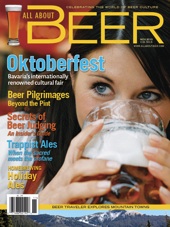So you’re at your local beer store, looking to purchase some of the fine Belgian brews you’ve been hearing so much about. How do you really know what you are getting?
Three categories of breweries—family brewers, lambic brewers, and Trappist breweries—are sufficiently under threat from more commercial entities that they have established associations to certify authentic beers and educate the public.
Belgian Family Brewers (www.belgianfamilybrewers.be) is a non-profit association of eleven independent breweries. All the members have been brewing continuously for at least 50 years.
The seal of the BFB will soon appear on the bottle labels of approved beers. One requirement for a beer to receive the seal is that it not be sold under any other label or name. The reason for this is that so-called “label” beers, etiketbier in Dutch, have become a problem in Belgium, as breweries re-label existing beers under new names, often when contract brewing for a supermarket or beer firm that markets beers it does not actually brew. This practice makes it very difficult for consumers to know that they may be drinking the same beer under several different names or labels. It’s really about truth in advertising and labeling.
Traditional lambic brewers, facing challenges from both non-traditional brewers and EU bureaucrats, have formed HORAL, an acronym that translates to “the high council for artisanal lambic beers.”
The ten members of HORAL—eight lambic breweries and two lambic blenders—seek to promote and protect traditionally produced lambic and gueuze brews. The chairman and founder is the energetic and driven brewer/blender Armand Debelder of Brouwerij Drie Fonteinen.
Why do traditional lambic and gueuze need protecting? There are a number of large Belgian breweries that produce very sweet beers they call “lambic,” using brewing methods that do not follow the traditional ways of creating such beers. These sweet brews are usually referred to as “commercial” by the members of HORAL, as such brews may have little in common with traditional lambic beers.
There is also a problem with the hygiene regulations of the European Union. Some overzealous bureaucrats have been trying to “clean up” lambic breweries, as they consider them unsanitary. Never mind that lambic has been brewed the same way for hundreds or even thousands of years. Hopefully common sense will prevail.
Finally, even a monk can be roused from his life of contemplation when competitors start to trespass on brand integrity. Ever since the 1930s, when the Trappist abbey beers really gained in popularity, there have been imitators who brew similar beers and label them as “abbey.” This is sometimes done even though there is no real connection between the brewery and abbey in question.
In 1997, the Trappist abbey breweries—now numbering six in Belgium and one in the Netherlands—formed the International Trappist Association (ITA) to prevent non-Trappist brewers from using the Trappist name. Now beer buyers can look for the “Authentic Trappist Product” seal on the bottle labels of these beers.
Although many of the abbey beers are fine brews in their own right, the Trappist logo does away with any confusion between “abbey” brews and authentic Trappist beers.











